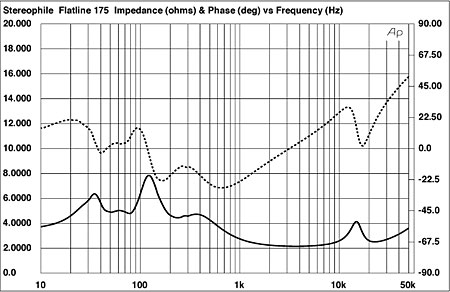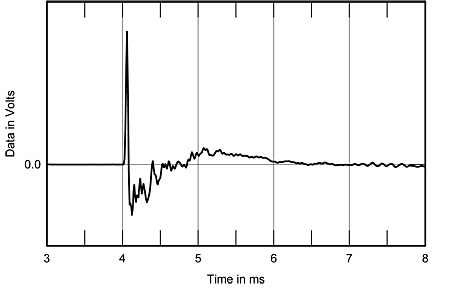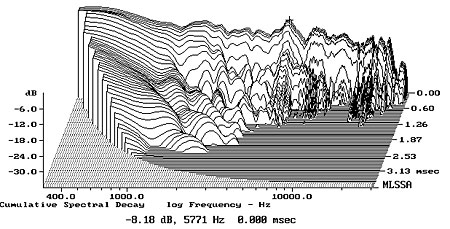| Columns Retired Columns & Blogs |
Flatline Design 175 loudspeaker Measurements
Sidebar 2: Measurements
Flatline's 175 is not very sensitive, 2.83V RMS of B-weighted noise raising an estimated sound-pressure level of just 82dB at 1m. This is much lower than the specified 88dB, and might contribute to RN's finding that the speakers lacked "jump factor." However, to some extent this will be compensated for by the ribbon's cylindrical-wavefront dispersion: the level drops with distance according to more of a 1/d law than the 1/d2 typical of point-source radiators.
The ribbon's impedance, shown separately on the right-hand side of fig.1, drops to a value of 2.4 ohms throughout the treble. This is broken only by the slight peak at 15kHz, this due to an equalization network in series with the ribbon. The rise in impedance below 1kHz and the negative phase angle are due to the crossover's high-pass filter. The woofer's impedance is shown on the left of fig.1: the peak at 140Hz, where the trace cuts that of the ribbon, is due to the crossover to the midrange unit. The woofer tuning is revealed by the slight peak at 35Hz, implying good LF extension. The slight wrinkle in the woofer trace that can be seen at 290Hz is probably due to a cabinet resonance of some kind. This wrinkle can also be seen in the overall impedance plot (fig.2). With an impedance magnitude below 4 ohms for most of the midband and treble, the Flatline 175 is a pretty demanding load for an amplifier to drive, though this is offset by the generally moderate phase angle. Incidentally, the unsupported nature of the crossover tray (see earlier) led the leads to the terminal posts to fracture while I was performing these impedance measurements.

Fig.1 Flatline 175, electrical impedance (solid) and phase (dashed) of ribbon (right) and moving-coil units (left) (2 ohms/vertical div.).

Fig.2 Flatline 175, electrical impedance (solid) and phase (dashed) (2 ohms/vertical div.).
Acoustically, the responses of the three drive-units on the ribbon axis with the microphone 35" from the ground are shown in fig.3. The woofer's output actually peaks between 60Hz and 100Hz—an octave higher than anticipated from the impedance measurement. The acoustic crossover to the 5" midrange unit takes place at 120Hz, with that unit rolling out above 500Hz. The ribbon comes in above 500Hz, with a shallow slope below that frequency leading to a slight but well-suppressed peak at 150Hz, this presumably the suspension resonance of the ribbon. In its passband, the ribbon's output looks rather uneven, with a rolled-off top octave.

Fig.3 Flatline 175, acoustic crossover on ribbon axis, 35" from floor, at 50" corrected for microphone response, with nearfield midrange, woofer, and ribbon responses below 500Hz, 700Hz, and 500Hz, respectively.
The overall system response on the same axis at a distance of 50" is shown in fig.4. The low frequencies roll out relatively early below 70Hz—RN did find that the 175's "bass region was adequate but understated"—though a slight shelving in the woofer's output results in useful output down to 30Hz. As is often found with planar speakers, the response appears to tilt down smoothly with increasing frequency. Partly this will be due to proximity effect at this relatively close microphone distance. (Because one of the radiating dimensions is so large, the usual assumption that the measuring microphone is in the speaker's farfield will no longer be valid, resulting in an apparent boost in the ribbon's lower octaves.) I investigated this phenomenon by repeating the measurement with a microphone distance of 100". Though this results in less resolution below 1kHz, it can be seen in fig.5 that the speaker is indeed better-balanced in the treble at the farther distance, though a deep notch appears in the ribbon's output at 15kHz. The ribbon's response still looks somewhat ragged, however.

Fig.4 Flatline 175, anechoic response on ribbon axis at 50" averaged across 30° horizontal window and corrected for microphone response, with complex sum of nearfield woofer and midrange responses below 300Hz.

Fig.5 Flatline 175, anechoic responses on ribbon axis at 50" (top) and 100" (bottom), corrected for microphone response ($s1?/?1?0-octave smoothed).
Laterally (fig.6), the ribbon maintains its treble response well off-axis, but at lower frequencies a notch develops to either side. Off-axis on the midrange side (the rear of the graph), this notch is in the crossover region between the midrange unit and the ribbon. On the ribbon side of the speaker, the position of the notch varies with off-axis angle, dropping in frequency for the more extreme angles. As expected from a line-source radiator, the vertical balance (fig.7) doesn't change significantly with height, though the chosen microphone axis (35" from the floor, halfway up the ribbon and level with my ears when I'm sitting down) appears to have less top-octave energy than positions just above or below.

Fig.6 Flatline 175, horizontal response family at 50", normalized to response on ribbon axis, from back to front: differences in response 90°–5° off-axis on midrange driver side; reference response; differences in response 5°–90° off-axis on ribbon side.

Fig.7 Flatline 175, vertical response family at 50", normalized to response on ribbon axis, from back to front: differences in response level with top of ribbon, then at 5" intervals down to axis 25" from floor.
In the time domain, the lazy overshoot below and above the zero axis in the Flatline's impulse response (fig.8), following the sharp up/down peak of the ribbon, correlates with the excessive bass and midrange levels noted earlier. Though RN didn't feel the ribbon to have any significant overhang, some residual ringing can be seen in the tail of the impulse. The speaker's step response (fig.9) reveals that the Flatline is not time-coherent, despite its use of first-order crossovers. The positive-going spike in the graph is the ribbon, followed by the negative-going midrange unit, then the positive-going woofer. Puzzled by this, I checked out the crossover circuit and individual drive-unit impulse responses in more detail: indeed, the ribbon and woofer are connected with positive polarity, the midrange unit with negative polarity. An enigma.

Fig.8 Flatline 175, impulse response on ribbon axis at 50" (5ms time window, 30kHz bandwidth).

Fig.9 Flatline 175, step response on ribbon axis at 50" (5ms time window, 30kHz bandwidth).
The cumulative spectral-decay, or waterfall, plot (fig.10) is surprisingly good for a system with a planar unit covering much of the audioband. Yes, a slight resonance can be seen at the cursor position (5.8kHz), and a couple of persistent modes extend past the 3.13ms mark. But here, I suspect, is much of the reason RN liked the speaker: it decays cleanly.

Fig.10 Flatline 175, cumulative spectral-decay plot at 50" (0.15ms risetime).
The impedance plot suggested the presence of a cabinet resonance at 290Hz. This resonance, along with two other modes at 148Hz and 80Hz, can be seen in fig.11, a waterfall plot calculated from the output of a simple accelerometer fastened to the front baffle midway between the midrange unit and the base. Though these are relatively low in level, the large radiating area of the affected wooden panel and the fact that it faces the listener might make this behavior significant. Indeed, RN was ambivalent about the speaker's performance in this frequency region.

Fig.11 Flatline 175, cumulative spectral-decay plot of accelerometer output fastened to center of enclosure front baffle halfway between the midrange unit and the floor. (MLS driving voltage to speaker, 7.55V; measurement bandwidth 2kHz.)
All things considered, the Flatline 175 illustrates why I hate measuring ribbons or other planar speakers: the interaction between the speaker and the measuring microphone is too complex for comfort at practical measuring distances; and, partly as a result, the things never measure satisfyingly flat—even when they sound flat! However, putting its problem areas—particularly the diminished low frequencies and the rather underdamped panels—to one side, these measurements go some way toward explaining why RN liked the 175's overall sound quality. They also explain why it's so fussy about setup. To a large extent, you will be able to fine-tune the 175 to get any balance you desire.—John Atkinson
- Log in or register to post comments




































